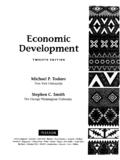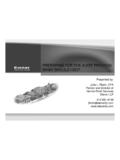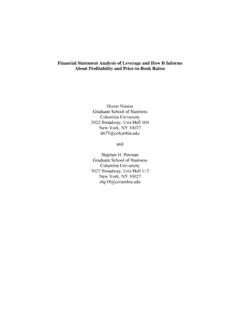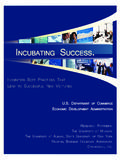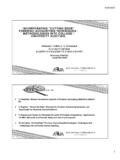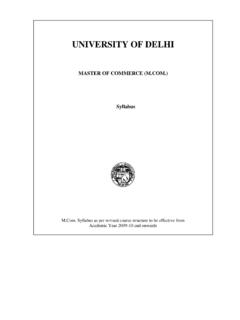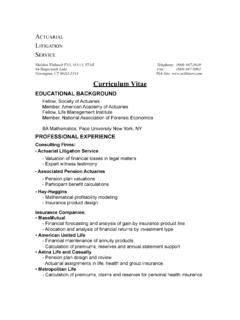Transcription of Financial Statement Analysis and Security Valuation
1 Financial StatementAnalysis andSecurity ValuationFourth EditionStephen H. PenmanColumbia UniversityMcGraw-HillIrwinBoston Burr Ridge, IL Dubuque, IA Madison, Wl new york San Francisco St. LouisBangkok Bogota Caracas Kuala Lumpur Lisbon London Madrid Mexico CityMilan Montreal New Delhi Santiago Seoul Singapore Sydney Taipei TorontoContentsList of Cases xxiiiList of Accounting Clinics xxivChapter 1 Introduction to Investing and Valuation 2 Investment Styles and Fundamental Analysis 3 Bubble, Bubble 6 How Bubbles Work 7 Analysts During the Bubble 8 Fundamental Analysis Anchors Investors 8 The Setting: Investors, Firms, Securities, andCapital Markets 8 The Business of Analysis .
2 The ProfessionalAnalyst 12 Investing in Firms: The Outside Analyst 12 Investing within Firms: The Inside A nalyst 13 The Analysis of Business 14 Strategy and Valuation 14 Mastering the Details 15 The Key Question: Sustainability of CompetitiveAdvantage 17 Financial Statements: The Lens on theBusiness 17 Choosing a Valuation Technology 17 Guiding Principles 18 Anchoring Value in the Financial Statements 20 How to Use This Book 21An Outline of the Book 21 The Web Connection 22 Key Concepts 22A Continuing Case: Kimberly-Clark Corporation 23 Concept Questions 27 Exercises 29 Minicase 31 Chapter 2 Introduction to the FinancialStatements 32 The Analyst's Checklist 33 The Form of the Financial Statements 33 The Balance Sheet 34 The Income Statement 34 The Cash Flow Statement 38 The Statement of Stockholders 'Equity 39 The Footnotes and Supplementary Informationto Financial Statements 40 The Articulation of the Financial Statements.
3 How the Statements Tell a Story 40 Measurement in the Financial Statements 41 The Price-to-Book Ratio 42 Measurement in the Balance Sheet 44 Measurement in the Income Statement 44 The Price-Earnings Ratio 49 The Reliability Criterion: Don't MixWhat You Know with Speculation 49 Tension in Accounting 51 Summary 52 The Web Connection 53 Key Concepts 53 The Analyst's Toolkit 54A Continuing Case: Kimberly-Clark Corporation 55 Concept Questions 60 Exercises 61 Minicase 66 PART ONEFINANCIAL STATEMENTSAND Valuation 72 Chapter 3 How Financial Statements AreUsed in Valuation 74 The Analyst's Checklist 75 Multiple Analysis 76 The Method of Comparables 76 Screening on Multiples 79 Asset-Based Valuation 82 Fundamental Analysis 84 The Process of Fundamental Analysis 85 Financial Statement Analysis , Pro FormaAnalysis, and Fundamental Analysis 86 The Architecture of Fundamental Analysis .
4 'The Valuation Model 88 Terminal Investments and Going-ConcernInvestments 89 Contents xviiValuation Models for Terminal Investments 90 Valuation Models for Going-ConcernInvestments 92 Criteria for a Practical Valuation Model 92 What Generates Value? 93 Valuation Models and Asset Pricing Models 9 7 Summary 97 The Web Connection 98 Key Concepts 98 The Analyst's Toolkit 99A Continuing Case: Kimberly-ClarkCorporation 100 Concept Questions 101 Exercises 101 Minicases 105 Appendix The Required Return and Asset PricingModels 110 Chapter 4 Cash Accounting, Accrual Accounting, andDiscounted Cash Flow Valuation 114 The Analyst's Checklist 115 The Dividend Discount Model 116 The Discounted Cash Flow Model 118 Free Cash Flow and Value Added 121 Simple Valuation Models 123 -The Statement of Cash Flows 124 The Cash Flow Statement under IFRS 126 Forecasting Free Cash Flows 127 Cash Flow, Earnings.
5 AndAccrual Accounting 128 Earnings and Cash Flows 128 Accruals, Investments, and the BalanceSheet 132 Summary 135 The Web Connection 136 Key Concepts 136 The Analyst's Toolkit 137A Continuing Case: Kimberly-Clark Corporation 137 Concept Questions 138 Exercises 139 Minicases 144 Chapter 5 Accrual Accounting and Valuation :Pricing Book Values 148 The Analyst's Checklist 149 The Concept Behind the Price-to-Book Ratio 149 Beware of Paying Too Much for Earnings 150 Prototype Valuations 150 Valuing a Project 150 Valuing a Savings Account 151 The Normal Price-to-Book Ratio 152A Model for Anchoring Value on Book Value 153 Residual Earnings Drivers and ValueCreation 156A Simple Demonstration and a SimpleValuation Model 158 Applying the Model to Equities 160 The Forecast Horizon and the Continuing ValueCalculation 161 Target Prices 164 Converting
6 Analysts' Forecaststo a Valuation 165 Applying the Model to Projects andStrategies 166 Features of the Residual EarningsModel 168 Book Value Captures Value and ResidualEarnings Captures Value Added toBook Value 169 Protection from Paying Too Much for EarningsGenerated by Investment 170 Protection from Paying Too Much for EarningsCreated by the Accounting 171 Capturing Value Not on the Balance Sheet for All Accounting Methods 172 Residual Earnings Are Not Affected byDividends, Share Issues, or ShareRepurchases 172 What the Residual Earnings Model Misses 173 Reverse Engineering the Model for ActiveInvesting 173 Reverse Engineering the S&P 500 176 Using Analysts 'Forecasts in ReverseEngineering 176 Implied Earnings Forecasts and EarningsGrowth Rates 177 Separating Speculation from What We Know: ValueBuilding Blocks 177 The Web Connection 180 Summary 180 Key Concepts 181 The Analyst's Toolkit 181A Continuing Case.
7 Kimberly-Clark Corporation 182 Concept Questions 183 Exercises 183 Minicases 189xviii ContentsChapter 6 Accrual Accounting and Valuation : PricingEarnings 192 The Analyst's Checklist 193 The Concept Behind the Price-Earnings Ratio 193 Beware of Paying Too Much for EarningsGrowth 194 From Price-to-Book Valuation to PIEV aluation 194 Prototype Valuation 195 The Normal Forward P/E Ratio 197 The Normal Trailing P/E Ratio 198A Poor P/E Model 199A Model for Anchoring Value on Earnings 199 Measuring Abnormal Earnings Growth 201A Simple Demonstration and a SimpleValuation Model 202 Anchoring Valuation on Current Earnings 203 Applying the Model to Equities 204
8 Converting Analysts'Forecasts toa Valuation 205 Features of the Abnormal Earnings Growth Model 206 Buy Earnings 207 Abnormal Earnings Growth Valuation andResidual Earnings Valuation 207 Abnormal Earnings Growth Is Not Affected byDividends, Share Issues, or ShareRepurchases 209 Accounting Methods and Valuation 209 Reverse Engineering the Model forActive Investing 211 Reverse Engineering the S&P 500 212 Using Analysts 'Forecasts in ReverseEngineering 212 Implied Earnings Forecasts and EarningGrowth Rates 213 Separating Speculation from What We Know: ValueBuilding Blocks 213P/E Screening 214 Screening on Earnings Yield 214 Screening on PEG Ratios 216 Summary 217 The Web Connection 218.
9 Key Concepts 218 The Analyst's Toolkit 218A Continuing Case: Kimberly-Clark Corporation 219 Concept Questions 220 Exercises 220 Minicases 226 PART TWOTHE Analysis OF FINANCIALSTATEMENTS 230 Chapter 7 Viewing the Business Through the FinancialStatements 232 The Analyst's Checklist 233 Business Activities: The Cash Flows 234 The Reformulated Cash Flow Statement 238 The Reformulated Balance Sheet 239 Business Activities: All Stocks and Flows 240 The Reformulated Income Statement 241 Accounting Relations that Govern ReformulatedStatements 241 The Sources of Free Cash Flow andthe Disposition of Free Cash Flow 242 The Drivers of Dividends 242 The Drivers of Net Operating Assets and NetIndebtedness 243 Tying It Together for Shareholders:What Generates Value?
10 244 Stocks and Flows Ratios: Business Profitability 246 Summary 248 The Web Connection 249 Key Concepts 249 The Analyst's Toolkit 250A Continuing Case: Kimberly-Clark Corporation 250 Concept Questions 251 Exercises 252 Chapter 8 The Analysis of the Statement ofShareholders' Equity 256 The Analyst's Checklist 257 Reformulating the Statement of Owners' Equity 257 Introducing Nike 258 Reformulation Procedures 258 Dirty-Surplus Accounting 262 Comprehensive Income Reporting under 263 Ratio Analysis 264 Payout and Retention Ratios 264 Shareholder Profitability 265 Growth Ratios 265
